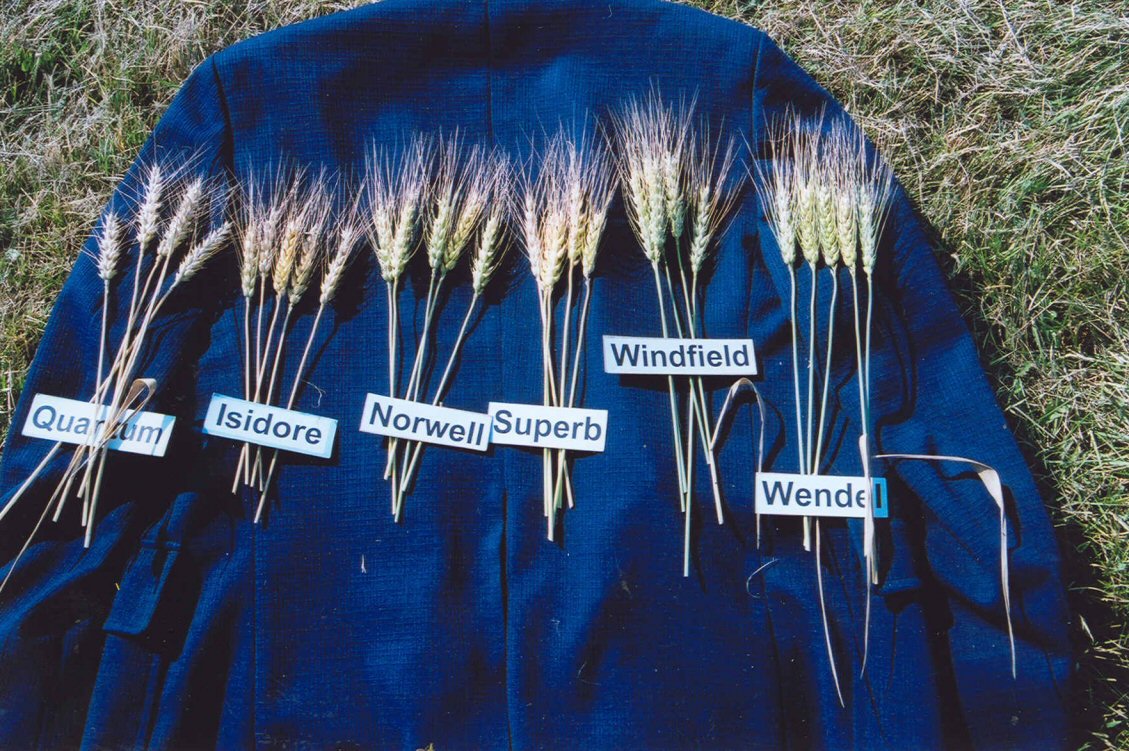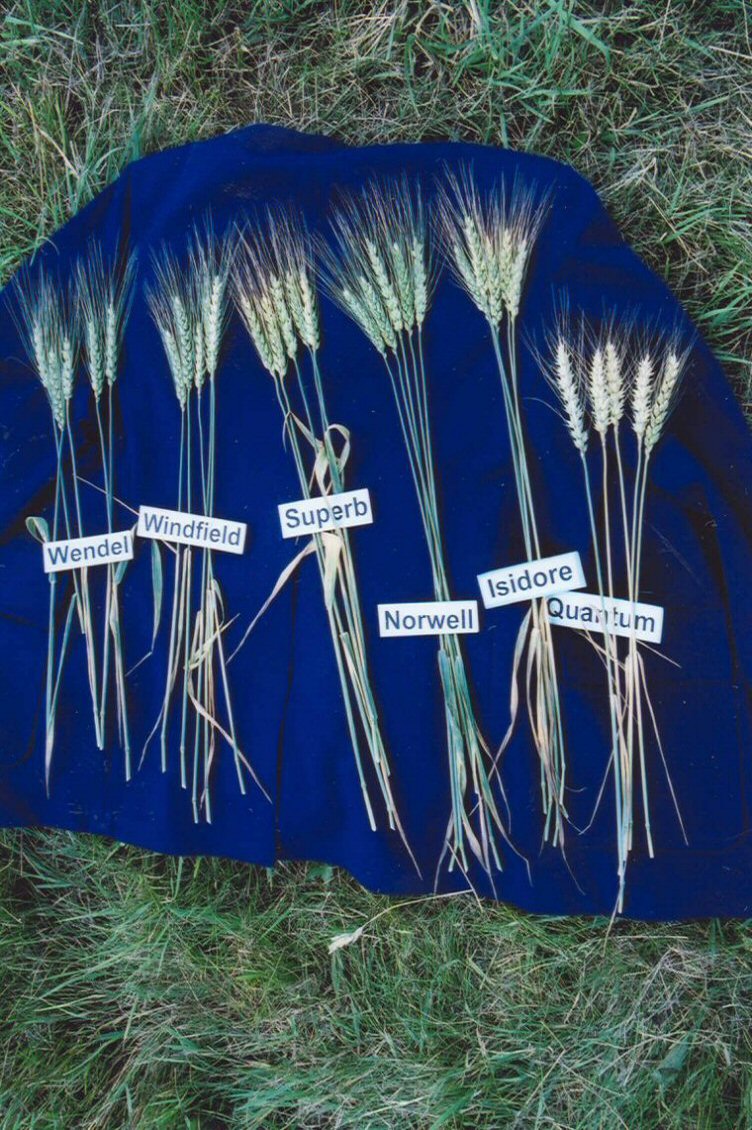Norwell
| Denomination: | 'Norwell' |
|---|---|
| Botanical Name: | Triticum aestivum |
| Applicant/Holder: |
Agriculture & Agri-Food Canada, Sainte-Foy Forage Crops 2560 Hochelaga Boulevard Sainte-Foy, Quebec G1V 2J3 Canada |
| Breeder: |
Harvey Voldeng, Agriculture & Agri-Food Canada, Ottawa, Ontario |
| Agent in Canada: |
University of Guelph Research Innovation Office Building #92, 50 Stone Road East Guelph, Ontario N1G 2W1 Canada Tel: 519-546-3398 |
| Application Date: | 2005-02-15 |
| Application Number: | 05-4573 |
| Grant of Rights Date: | 2009-01-15 |
| Certificate Number: | 3438 |
| Date rights surrendered: | 2020-01-15 |
Variety Description
Varieties used for comparison: 'Quantum', 'Winfield', 'Superb' and 'Wendel'
Summary: 'Norwell' has a more erect growth habit than 'Winfield', 'Superb' and 'Wendel'. 'Norwell' matures earlier than 'Wendel' and later than 'Quantum'. 'Norwell' has weaker glaucosity on the lower side of the flag leaf than 'Quantum', 'Superb' and 'Wendel'. The flag leaf auricles of 'Norwell' have weaker pubescence than those of 'Quantum' and weaker anthocyanin colouration than those of 'Superb'. Glaucosity of the flag leaf sheath and culm neck is moderate and weak to moderate, respectively, for 'Norwell' while it is strong to very strong for 'Quantum'. At maturity, the attitude of the spikes of 'Norwell' is inclined while it is erect for 'Superb' and 'Wendel'. The lower glumes of 'Norwell' have an elevated shoulder while those of 'Quantum', 'Winfield' and 'Wendel' are sloping to slightly sloping. 'Norwell' has smaller kernels than 'Superb' and shorter kernel brush hairs than 'Superb' and 'Wendel'. 'Norwell' has a stronger resistance to Barley Yellow Dwarf viruses than 'Winfield' and 'Superb' and a stronger resistance to powdery mildew than 'Superb'. Resistance to Fusarium Head Blight is stronger for 'Norwell' than it is for 'Quantum' and 'Superb'.
Description:
YOUNG PLANT (4 leaf stage): absent or very weak anthocyanin colouration of coleoptiles, glabrous sheaths, densely pubescent lower leaf blades
PLANT: spring type, erect to semi-erect growth habit, mid-season maturity, low tendency to recurved flag leaves
STEM AT MATURITY: moderately thick walled in cross-section, no anthocyanin colouration
CULM NECK: weak to medium glaucosity, weak to moderate curvature
FLAG LEAF: dark green, glabrous on upper side, very weak glaucosity on lower side, intermediate between upright and drooping attitude
FLAG LEAF SHEATH: glabrous, medium glaucosity
FLAG LEAF AURICLES: absent or very weak anthocyanin colouration, no pubescence of margins
SPIKE: parallel sided, medium density, inclined attitude at maturity, medium to strong glaucosity, white at maturity
AWNS: medium length, mostly spreading attitude, white
LOWER GLUME: medium width, medium length, glabrous, elevated shoulder, medium width shoulder, straight beak, medium length beak, sparse internal hairs
LEMMA: slightly curved beak, dark green markings with bluish tinge on green yellow background
KERNEL: hard red type, medium to dark red, small to medium size, medium length, medium width, ovate, rounded cheeks, medium length brush hairs, medium width crease, medium depth crease
GERM: medium size, round
QUALITY CHARACTERISTICS: good bread quality
RESISTANCE TO DISEASE: moderate resistance to powdery mildew (Erysiphe graminis f.sp. tritici), moderate resistance to Fusarium Head Blight (Fusarium graminearum, Fusarium species), moderate susceptibility to Leaf Rust (Puccinia triticina), moderate resistance to the Barley Yellow Dwarf Virus
Origin & Breeding History: 'Norwell' (experimental designation B89-12-51-1248) originated from the cross Max/PT742//Bluesky///Max/Coteau//Bluesky made by the breeder, Dr. Jean-Pierre Dubuc, at Agriculture and Agri-food Canada in St-Foy, Québec in 1989. The breeding technique used was Modified Bulk. From 1997 to 1999, tests were conducted on selected lines in a number of locations including Ridgetown, Centralia, Kemptville and Ottawa in Ontario. Final selection of 'Norwell' was made in the F7 and F8 generations based on Fusarium resistance, Barley Yellow Dwarf resistance, kernel cross-section type, kernel size, grain density, plant appearance, number of heads produced per unit area, cleanliness of leaves, percent protein, percent moisture, alpha amylase activity and loaf characteristics. In 2001, 'Norwell' was tested in 9 locations across Ontario and in 10 locations within Ontario in 2002. In both years, it was tested for Fusarium Head blight susceptibility under inoculated conditions as well as baking quality.
Tests & Trials: The tests and trials for 'Norwell' were conducted during the summers of 2005 and 2006 in Ridgetown, Ontario. Plots consisted of 6 rows, 4 metres in length at 15 cm row spacing with 40 cm between plots. There were 4 replicates arranged in a Random Complete Block Design.
Comparison tables for 'Norwell' with reference varieties 'Quantum', 'Winfield', 'Superb' and 'Wendel'
Flag leaf width (mm)
| 'Norwell' | 'Quantum' | 'Winfield' | 'Superb' | 'Wendel' | |
|---|---|---|---|---|---|
| mean | 12.6 | 12.9 | 14.2 | 16.1 | 14.2 |
| std. deviation | 0.8 | 0.7 | 1.2 | 1.7 | 1.0 |
Days to heading
| 'Norwell' | 'Quantum' | 'Winfield' | 'Superb' | 'Wendel' | |
|---|---|---|---|---|---|
| 2005 | 163 | 163 | 168 | 165 | 167 |
| 2006 | 160 | 158 | 165 | 161 | 165 |
Height at heading (including awns) (cm)
| 'Norwell' | 'Quantum' | 'Winfield' | 'Superb' | 'Wendel' | |
|---|---|---|---|---|---|
| mean | 101 | 99 | 107 | 93 | 81 |
| std. deviation | 3.0 | 2.2 | 3.5 | 3.4 | 5.8 |
Kernel test weight (kg/hectolitre)
| 'Norwell' | 'Quantum' | 'Winfield' | 'Superb' | 'Wendel' | |
|---|---|---|---|---|---|
| 2005 | 77.4 | 75.8 | 74.8 | 76.4 | 74.2 |
| 2006 | 76.8 | 75.8 | 74.2 | 74.4 | 72.0 |
Click on image for larger view

Wheat: 'Norwell' (centre left) with reference varieties 'Quantum' (left), 'Superb' (centre right), 'Windfield' (centre right) and 'Wendel' (right)
Click on image for larger view

Wheat: 'Norwell' (centre right) with reference varieties 'Quantum' (right), 'Superb' (centre left), 'Windfield' (centre left) and 'Wendel' (left)
- Date modified: